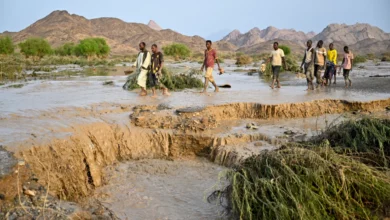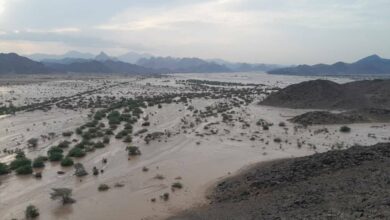Mohamed Kassas is a living legend. Anyone with an interest in Egypt's environmental issues is familiar with this 90-year old ray-ban bespectacled professor of botany from Cairo University. His long and rich career reflects the environmental history of Egypt.
Born in 1921 in a tiny fishing village located at the junction of the Mediterranean and Lake Burullos, Kassas developed an early passion for nature and biodiversity. “Fishermen have to take nature's cycles into consideration, because fishing is a seasonal activity and the wind and climatic conditions prevail,” he explains, stressing that these factors induced a strong sense of animal life-cycles into this coastal community. Growing up in this natural environment, he would roam the shores of the lake and the coastine, always on the lookout for various types of animals and plants.
When he moved to Cairo in 1940 to study science at Cairo University, his acute interest in and knowledge of nature led him to major in botany. Cairo’s location in the desert led him to focus his research on plant ecology in arid lands.
Plant ecology, as he explains, is the study of the two-way interaction between the plant and its environment. “On the one hand, we study how the plant is influenced by its environment — the nature of the soil, the temperature, the light — and on the other hand we figure out how the environment is affected by the presence of this plant, because when a plant or a tree creates shade it reduces the temperature and it also purifies the atmosphere by absorbing carbon dioxide and releasing oxygen,” he explains.
His interest in desertification appeared a few years later, between 1953 and 1956, when he taught botany at the University of Khartoum in Sudan. Desertification refers to the degradation of land, either by natural causes like drought and high salt levels in the water, or by human action such as unsound drainage, overgrazing and general mismanagement of arable lands.
“Egypt is not a good place to study desertification, because it’s a desert country. Sudan, on the other hand, offered much more because it offers parallel lines of rainfall from the north to the south that are well delimited. The north is desert with very little rainfall, while going southward the rain is much more common.” Superimposing maps of rainfall and vegetation should have exposed an exact parallelism, but the reality was completely different and scary.
“The map of vegetation belts I used had been drawn 30 years earlier, and I noticed that the belts of vegetation had shifted downwards.” Steppes had turned into a desert, and he calculated that in 30 years the vegetation belt had shifted downwards at the rate of several kilometers a year.
In 1969, Kassas presented his paper on desertification at an international conference on arid lands in Virginia. “This was the first time that the word 'desertification' was used in English, he says, and it became a bad omen, because the 70’s witnessed unprecedented droughts in Africa that accelerated the process of desertification in the Sahara.”
As a consequence, stemming desertification became a priority on the environmental agenda of many countries, including Africa, Latin America, Asia and the United States, which all realized that their arid lands were touched by the galloping desertification process. “Desertification became such a menace that the United Nations decided to hold the first world conference on desertification in Nairobi in 1977,” Kassas explains.
In 1982 the UN held its second conference on the environment, and desertification was one of the major issue discussed, as well as climate change. It is during this conference that it was decided to have a UN convention on desertification written and drafted by 1994. Kassas explains that before the 70’s, the concept of “desertification” was widely misunderstood. “People thought that the desert was coming out of its boundaries and expanding to overwhelm productive areas,” he says with a discreet smile.
He stresses that the movement of sand dunes is a reality, but that it is only responsible for 10 percent of desertification. “On the contrary, desertification starts on the productive lands that are misused, and whose resources are mismanaged and overused until the land breaks down and deteriorates completely.”
The bare land adds itself to the desert, and not the other way round. “When you want to combat desertification, Kassas explains, you need to correct management systems on the land to make sure that the number of livestock heads is right, and respect the line when you should not cultivate more.”
Between 1978 and 1984, Mohamed Kassas became the president of the International Union for Conservation of Nature (IUCN), the world’s oldest and largest environmental network, which gathers 1000 governmental and non-governmental organizations, along with 11,000 volunteers, worldwide, in 160 countries.
“While I was president of the IUCN, my colleague Mustafa Tolba was at the head of the United Nations Environment Program,” he says. After a moment of reflection, he explains with an affable tone, as if to hide a hint of pride, that “these were years when two Egyptians played an important and efficient role on an international level.”
His role on a national level was no less remarkable. He was appointed member of the Shura Council in 1981 and spurred interest concerning environmental issues in Egypt, at a time when it was nothing more than a shadowy concept for most citizens. He helped a number of NGOs raise funds and lobbied actively to develop institutions concentrating on environmental issues at universities. He also created a library for environmental science at Cairo University; the library is consulted by experts all over the country.
Kassas’ involvement in environmental issues got him into serious trouble with the government on two occasions. When former President Gamal Abdel Nasser initiated the high dam project, he conducted the first national environmental impact assessment to determine the potential consequences of this gargantuan project. With honesty, he explains that “none of the senior experts at the time were against the construction of the high dam, but all of us agreed that some issues related to the construction were worth looking into.”
In 1969, he presented a paper during the first international conference on environment and development in Virginia on the future of erosion in the Nile Delta. This presentation caused a slight fuss when the Egyptian ambassador in London read an article published in a British magazine that exposed the results of Kassas’ study.
“The problem with the Egyptian government, and with many governments in general, is that they confuse technical opinion with political stances,” he explains.
In 1997, Kassas got another angry reaction from politicians when he announced his opposition to the New Valley Project, or Toshka Project, which consisted of building a system of canals to carry water from Lake Nasser to irrigate the Western Desert and increase the amount of agricultural land. “I told them that we did not have enough water to achieve this project, and I was kicked out of the Shura Council!” he exclaims with a laugh.
Today, at 90 years of age, Mohamed Kassas sits every morning from 8 am to 12 pm in his office at Cairo University, surrounded by files that reach the ceiling, and receives visits from researchers and students who enter and exit his office in a constant ballet. Retirement, as opposed to arid land and desertification, is a concept he has no intention of realizing. Perhaps, that is for the best.




